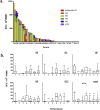Seasonal influenza vaccination is the strongest correlate of cross-reactive antibody responses in migratory bird handlers
- PMID: 25491354
- PMCID: PMC4324241
- DOI: 10.1128/mBio.02107-14
Seasonal influenza vaccination is the strongest correlate of cross-reactive antibody responses in migratory bird handlers
Abstract
Avian species are reservoirs of influenza A viruses and could harbor viruses with significant pandemic potential. We examined the antibody and cellular immune responses to influenza A viruses in field or laboratory workers with a spectrum of occupational exposure to avian species for evidence of zoonotic infections. We measured the seroprevalence and T cell responses among 95 individuals with various types and degrees of prior field or laboratory occupational exposure to wild North American avian species using whole blood samples collected in 2010. Plasma samples were tested using endpoint enzyme-linked immunosorbent assay (ELISA) and hemagglutination (HA) inhibition (HAI) assays to subtypes H3, H4, H5, H6, H7, H8, and H12 proteins. Detectable antibodies were found against influenza HA antigens in 77% of individuals, while 65% of individuals tested had measurable T cell responses (gamma interferon [IFN-γ] enzyme-linked immunosorbent spot assay [ELISPOT]) to multiple HA antigens of avian origin. To begin defining the observed antibody specificities, Spearman rank correlation analysis showed that ELISA responses, which measure both head- and stalk-binding antibodies, do not predict HAI reactivities, which measure primarily head-binding antibodies. This result suggests that ELISA titers can report cross-reactivity based on the levels of non-head-binding responses. However, the strongest positive correlate of HA-specific ELISA antibody titers was receipt of seasonal influenza virus vaccination. Occupational exposure was largely uncorrelated with serological measures, with the exception of individuals exposed to poultry, who had higher levels of H7-specific antibodies than non-poultry-exposed individuals. While the cohort had antibody and T cell reactivity to a broad range of influenza viruses, only occupational exposure to poultry was associated with a significant difference in antibody levels to a specific subtype (H7). There was no evidence that T cell assays provided greater specificity for the detection of zoonotic infection. However, influenza vaccination appears to promote cross-reactive antibodies and may provide enhanced protection to novel influenza viruses.
Importance: Annual vaccinations are necessary to ameliorate influenza disease due to drifted viral variants that emerge in the population. Major shifts in the antigenicity of influenza viruses can result in immunologically distinct viruses that can cause more severe disease in humans. Historically, genetic reassortment between avian, swine, or human influenza viruses has caused influenza pandemics in humans several times in the last century. Therefore, it is important to design vaccines to elicit broad protective responses to influenza infections. Because avian influenza viruses have an important role in emerging infections, we tested whether occupational exposure to birds can elicit immune responses to avian influenza viruses in humans. Instead of a specific occupational exposure, the strongest association of enhanced cross-reactive antibody responses was receipt of seasonal influenza vaccination. Therefore, individuals with preexisting immune responses to seasonal human influenza viruses have substantial cross-reactive antibody and T cell responses that may lead to enhanced protection to novel influenza viruses.
Copyright © 2014 Oshansky et al.
Figures





References
-
- Tong S, Li Y, Rivailler P, Conrardy C, Castillo DA, Chen LM, Recuenco S, Ellison JA, Davis CT, York IA, Turmelle AS, Moran D, Rogers S, Shi M, Tao Y, Weil MR, Tang K, Rowe LA, Sammons S, Xu X, Frace M, Lindblade KA, Cox NJ, Anderson LJ, Rupprecht CE, Donis RO. 2012. A distinct lineage of influenza A virus from bats. Proc. Natl. Acad. Sci. U. S. A. 109:4269–4274. 10.1073/pnas.1116200109. - DOI - PMC - PubMed
-
- Tong S, Zhu X, Li Y, Shi M, Zhang J, Bourgeois M, Yang H, Chen X, Recuenco S, Gomez J, Chen LM, Johnson A, Tao Y, Dreyfus C, Yu W, McBride R, Carney PJ, Gilbert AT, Chang J, Guo Z, Davis CT, Paulson JC, Stevens J, Rupprecht CE, Holmes EC, Wilson IA, Donis RO. 2013. New world bats harbor diverse influenza A viruses. PLoS Pathog. 9:e1003657. 10.1371/journal.ppat.1003657. - DOI - PMC - PubMed
Publication types
MeSH terms
Substances
Grants and funding
LinkOut - more resources
Full Text Sources
Other Literature Sources
Medical
